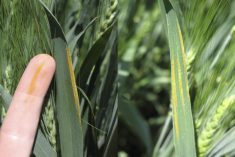Spring has been tough on many canola crops in northwestern Saskatchewan.
“Canola — it’s kind of hit and miss. They’re just all over the place,” said Stephanie McMillan, an agronomist with AgriTeam Services at Glaslyn, Sask., about 90 km south of Meadow Lake.
One field might have some plants at the two- to four-leaf stage, and others at the five- to six-leaf stage, she said.
Canola crops are a couple of weeks behind normal development, she said — and how hard late frosts, flea beetles and dry weather would hit canola yield remains to be seen.
Read Also

India slaps 30 per cent import duty on yellow peas
India has imposed a 30 per cent duty on yellow pea imports with a bill of lading date on or after Nov. 1, 2025.
“If we keep getting those shots of rain up till harvest, we might still be able to do OK,” she said.
Geoff Schick, operations manager at AgriTeam, was also optimistic that canola crops could recover in the next week if they got some moisture. “The heat’s going to be the worst thing on it now.”
Other crops are faring better this year. Both Schick and McMillan said cereals were generally looking good in the area.
Cereals were thick, uniform and at the normal stage of crop development, said McMillan.
Peas also look good, she said. Some pea plants had shot out a secondary stem because of fros; whether those plants suffer a yield drop remains to be seen, she said.
Precipitation spotty
“I think we’re better off than a lot of places in the province ’cause we have had some rain,” said Schick.
But precipitation has been “hit and miss,” he said. The Midnight Lake area, just north of Glaslyn, was almost wet enough to get stuck during a recent drive.
Meanwhile, 11 km south of Midnight Lake, there was “dust flying,” said Schick.
Livelong, about 30 km northwest of Glaslyn, has only seen trace amounts of rain in the last week.
And drought goes hand-in-hand with grasshoppers. Grasshoppers seem to be “creeping up on us right now,” said Schick.
McMillan said she knew of one local farmer who had sprayed for hoppers, and others should keep an eye on them. “They’re probably going to be on the edges of the fields, but definitely be walking into the middle, and see if they’re hopping,” she said.
McMillan doesn’t foresee disease issues this year if the weather stays dry. But farmers could see disease set in, especially in damaged or stressed crops, if the weather turns wet, she said.
Schick said farmers should also check to make sure their herbicides were working. They’d had some reports of herbicides not doing the job, he said.
— Lisa Guenther is a field editor for Grainews and Country Guide at Livelong, Sask. Follow her at @LtoG on Twitter.













